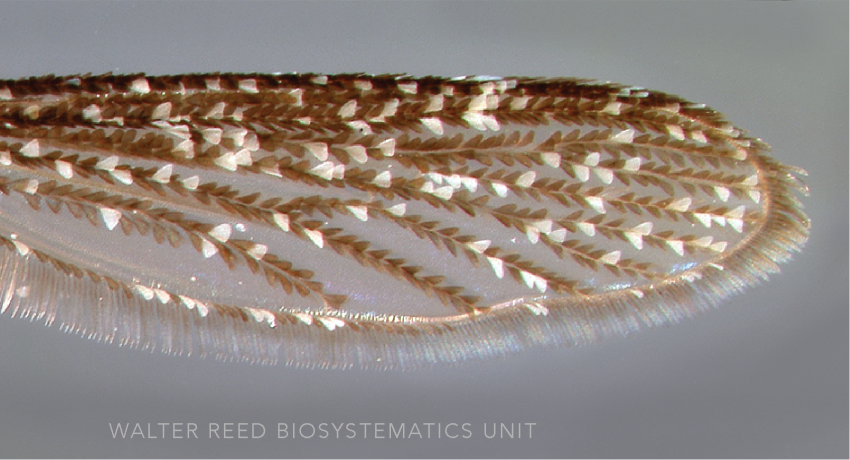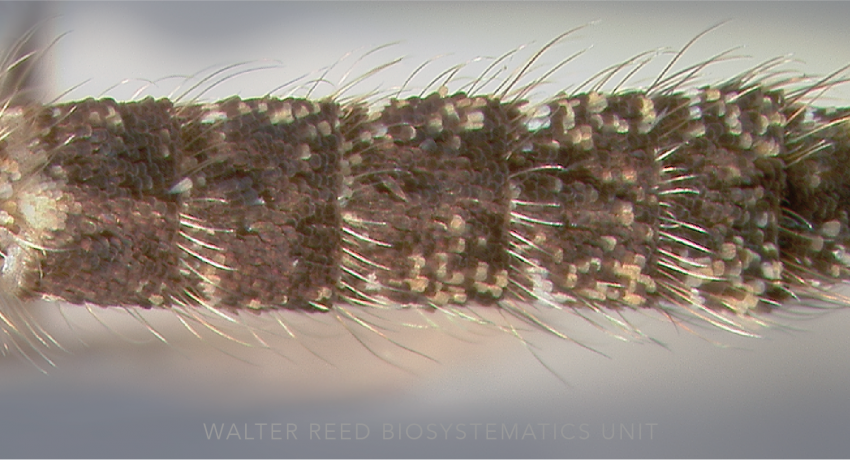AFROTROPICAL REGION
Etymology: fork bearing (L); ref. to “forked male claspers”.
The species now known as Aedes furcifer was first described as Mansonia nigra by Theobald in 1906. In 1913, Edwards proposed furcifer as a new name for nigra Theobald, thus the type of nigra and its associated type information—from Sudan, housed at NHMUK, now stands for Ae. furcifer. Aedes furcifer is the nominotypical member of the informal Furcifer Group within the Aedes subgenus Diceromyia, which also includes Ae. taylori Edwards and Ae. cordellieri Huang. These three species are most reliably differentiated on characters of the male genitalia, although adult female Ae. furcifer and Ae. taylori can be distinguished on the abundance and patterning of the abdominal scales. Many studies have lumped the latter two taxa as “furcifer-taylori’, leading to uncertainty on the true species distributions, bionomics and vector competency.
Type locality: (as nigra Theobald: Sudan)
Type depository: (as nigra Theobald: Natural History Museum, London, England, United Kingdom (NHMUK)
DIAGNOSTIC CHARACTERS (Click photos to view; mouse over and click large photo to zoom in.)
ADULT (illustrated): Head: Proboscis with broad median pale band. Legs: Fe-I–III, Ti-I–III, Ta-I–III1 speckled with pale scales. Wing: Alula with broad scales; wing scales broad on all veins, dark mixed with white; tertiary fringe scales mix of pale and dark. Thorax: Erect forked scales numerous, not restricted to occiput; paratergite with scales; upper prealar area with broad scales; mesepimeral scales present; lower mesepimeral setae present. Thorax: Scutellar lobes all with broad scales; acrostichal and dorsocentral setae well developed; scutum mottled dark anteriorally; prescutellar setae well developed. Abdomen: Terga and sterna with pale speckling.
LARVA (not illustrated): No larval characters defined.
TAXONOMIC KEYS
Jupp 1996 (M*, F*; key)
Huang & Rueda 2016 (F*; key)
![]()
WRBU – Aedes – Afrotropical – Larva
Exemplar DNA sequences
Ae. furcifer COI: MG242495, KU187186
BIONOMICS
Immatures
Aedes furcifer immatures are found in tree holes, and rot holes.
Adults
Like Ae. taylori, Ae. furcifer are found in Afrotropical forest and forest edge habitats. Aedes furcifer feeds both on monkeys high in the canopy, and on people and baboons at the ground level. This behavior increases their importance as zoonotic disease vectors.
DISTRIBUTION NOTES
Burkina Faso, Central African Republic, Côte d'Ivoire, Ethiopia, Gambia, Ghana, Guinea Bissau, Kenya, Mali, Nigeria, Senegal, Sudan & South Sudan, Tanzania, Togo, Uganda.

WRBU VECTOR HAZARD REPORTS
None; View other WRBU Vector Hazard Reports
Available GIS Models:
IMPORTANT REFERENCES (full citations below)
Theobald 1906b: 80 (F*; as Mansonia nigra).
Edwards 1913b: 48 (new name for nigra Theobald, not Giles 1904b; Ochlerotatus)
Edwards 1941: 214 (M*, F), 401 (P*)
Lewis 1942a: 153 (P, L)
Hopkins 1952: 213 (L)
Reinert 1972b: 87 (E*)
Port et al. 1981: 163 (distr. The Gambia)
Ferrara et al. 1985 (1984): 179 (F*; furcifer/taylori comparison)
Hervy et al. 1985 (L*; furcifer/taylor comparison)
Huang 1986a: 634 (tax. Furcifer Group)
Jupp et al. 1993 (s.l.; tax. distr.)
Jupp 1996 (M*, F*; key)
Jupp 1998 (tax. comp. morph.)
Reinert 2000e: Fig. 17 (F*)
Huang & Rueda 2016 (F*; key)
CURRENT SYNONYMS
syn. nigra Theobald
1906b: 80 (F*; Mansonia). Type locality: Blue Nile, Sudan (NHMUK).
syn. africana Theobald
1911c: 151 (M*, F*; Diceromyia; not Stegomyia africana Theobald 1901d). Type locality: Nasser, Sobat River, Sudan (NHMUK).
CITED REFERENCES
Edwards, F.W. (1913b). Further notes on African Culicidae. Bulletin of Entomological Research, 4, 47–59.
Edwards, F.W. (1941). Mosquitoes of the Ethiopian Region. III. Culicine adults and pupae. Bulletin of the British Museum (Natural History) Entomology.
Ferrara, L., Germain, M., & Hervy, J.-P. (1985). Aedes (Diceromyia) furcifer (Edwards, 1913) et Aedes (Diceromyia) taylori Edwards, 1936. Le point sur la differenciation des adultes. Cahier ORSTOM. Série Entomologie Médicale et Parasitologie, 22 (1984) (3), 179–183.
Hervy, J. P., Ferrara, L., & Legros, F. (1985). Aedes (Diceromyia) furcifer (Edwards, 1913) et Aedes (Diceromyia) taylori Edwards, 1936: diagnose des larves de quatrieme stade. Cahier ORSTOM. Série Entomologie Médicale et Parasitologie, 23(1), 17–24.
Hopkins, G.H.E. (1952). Mosquitoes of the Ethiopian region. I. Larval bionomics of mosquitoes and taxonomy of culicine larvae (2nd ed.). London, UK: British Museum (Natural History).
Huang, Y.-M. (1986a). Notes on the Aedes (Diceromyia) furcifer group, with a description of a new species (Diptera: Culicidae). Proceedings of the Entomological Society of Washington, 88, 634–649.
Huang, Y.-M., & Rueda, L.M. (2016). A pictorial key to the sections, groups, and species of the Aedes (Diceromyia) in the Afrotropical Region (Diptera: Culicidae). Zootaxa, 4079(2), 281–290.
Jupp, P.G. (1996). Mosquitoes of southern Africa. Culicinae and Toxorhynchitinae. Ekogilde Publishers, Hartebeespoort, South Africa, 156pp.
Jupp, P.G. (1998). Aedes (Diceromyia) furcifer (Edwards) and Aedes (Diceromyia) cordellieri Huang in southern Africa: distribution and morphological differentiation. Journal of the American Mosquito Control Association, 14(3), 273–276.
Jupp, P.G., McIntosh, B.M., & Kemp, A. (1993). The Aedes (Diceromyia) furcifer group (Diptera: Culicidae) in southern Africa: identification and occurrence of Ae. furcifer (Edwards) and Ae. cordellieri Huang. African Entomology, 1(1), 126–128.
Lewis, D.J. (1942a). The early stages of Aedes taylori Edwards and A. furcifer Edwards (Dipt., Culicidae). Proceedings of the Royal Entomological Society of London. Series B, Taxonomy, 11, 153–154.
Port, G.R., Wilkes, T.J., & Bryan, J.H. (1981). A note on the distribution of Aedes (Diceromyia) furcifer/taylori, a yellow fever vector, in the Gambia. Insect Science and Its Application, 2(3), 163–166.
Reinert, J.F. (1972b). Description of the egg of Aedes (Diceromyia) furcifer (Edwards) (Diptera: Culicidae). Mosquito Systematics, 4(3), 87–89.
Reinert, J.F. (2000e). Comparative anatomy of the female genitalia of genera and subgenera in tribe Aedini (Diptera: Culicidae). Part V. Genus Aedes Meigen. Contributions of the American Entomological Institute, 32(3), 1–102.
Theobald, F.V. (1906b). Report on economic entomology. Part I. Second report on the mosquitoes or Culicidae of the Sudan. Report Wellcome Laboratories, Gordon College, Khartoum, 2, 67–83.
Theobald, F.V. (1911c). A new genus and two new species of Culicidae from the Sudan. Khartoum Report Wellcome Research Lab, 4(Vol. B), 151–156.
CITE THIS PAGE
Walter Reed Biosystematics Unit (Year). Aedes furcifer species page. Walter Reed Biosystematics Unit Website, http://wrbu.si.edu/vectorspecies/mosquitoes/furcifer, accessed on [date (e.g. 03 February 2020) when you last viewed the site].










































































































































































